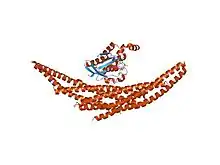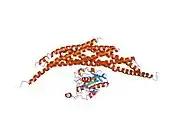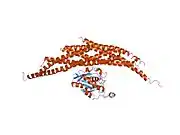RAC1
Rac1, also known as Ras-related C3 botulinum toxin substrate 1, is a protein found in human cells. It is encoded by the RAC1 gene.[5][6] This gene can produce a variety of alternatively spliced versions of the Rac1 protein, which appear to carry out different functions.[7]
Function
Rac1 is a small (~21 kDa) signaling G protein (more specifically a GTPase), and is a member of the Rac subfamily of the family Rho family of GTPases. Members of this superfamily appear to regulate a diverse array of cellular events, including the control of GLUT4[8][9] translocation to glucose uptake, cell growth, cytoskeletal reorganization, antimicrobial cytotoxicity,[10] and the activation of protein kinases.[11]
Rac1 is a pleiotropic regulator of many cellular processes, including the cell cycle, cell-cell adhesion, motility (through the actin network), and of epithelial differentiation (proposed to be necessary for maintaining epidermal stem cells).
Role in cancer
Along with other subfamily of Rac and Rho proteins, they exert an important regulatory role specifically in cell motility and cell growth. Rac1 has ubiquitous tissue expression, and drives cell motility by formation of lamellipodia.[12] In order for cancer cells to grow and invade local and distant tissues, deregulation of cell motility is one of the hallmark events in cancer cell invasion and metastasis.[13] Overexpression of a constitutively active Rac1 V12 in mice caused a tumor that's phenotypically indistinguishable from human Kaposi's sarcoma.[14] Activating or gain-of-function mutations of Rac1 are shown to play active roles in promoting mesenchymal-type of cell movement assisted by NEDD9 and DOCK3 protein complex.[15] Such abnormal cell motility may result in epithelial mesenchymal transition (EMT) – a driving mechanism for tumor metastasis as well as drug-resistant tumor relapse.[16][17]
Role in glucose transport
Rac1 is expressed in significant amounts in insulin sensitive tissues, such as adipose tissue and skeletal muscle. Here Rac1 regulated the translocation of glucose transporting GLUT4 vesicles from intracellular compartments to the plasma membrane.[9][18][19] In response to insulin, this allows for blood glucose to enter the cell to lower blood glucose. In conditions of obesity and type 2 diabetes, Rac1 signaling in skeletal muscle is dysfunctional, suggesting that Rac1 contributes to the progression of the disease. Rac1 protein is also necessary for glucose uptake in skeletal muscle activated by exercise[8][20] and muscle stretching[21]
Clinical significance
Activating mutations in Rac1 have been recently discovered in large-scale genomic studies involving melanoma [22][23][24] and non-small cell lung cancer.[25] As a result, Rac1 is considered a therapeutic target for many of these diseases.[26]
A few recent studies have also exploited targeted therapy to suppress tumor growth by pharmacological inhibition of Rac1 activity in metastatic melanoma and liver cancer as well as in human breast cancer.[27][28][29] For example, Rac1-dependent pathway inhibition resulted in the reversal of tumor cell phenotypes, suggesting Rac1 as a predictive marker and therapeutic target for trastuzumab-resistant breast cancer.[28] However, given Rac1's role in glucose transport, drugs that inhibits Rac1 could potentially be harmful to glucose homeostasis.
Dominant negative or constitutively active germline RAC1 mutations cause diverse phenotypes that have been grouped together as Mental Retardation Type 48.[30] Most mutations cause microcephaly while some specific changes appear to result in macrocephaly.
Interactions
RAC1 has been shown to interact with:
References
- GRCh38: Ensembl release 89: ENSG00000136238 - Ensembl, May 2017
- GRCm38: Ensembl release 89: ENSMUSG00000001847 - Ensembl, May 2017
- "Human PubMed Reference:". National Center for Biotechnology Information, U.S. National Library of Medicine.
- "Mouse PubMed Reference:". National Center for Biotechnology Information, U.S. National Library of Medicine.
- Didsbury J, Weber RF, Bokoch GM, Evans T, Snyderman R (Oct 1989). "rac, a novel ras-related family of proteins that are botulinum toxin substrates". The Journal of Biological Chemistry. 264 (28): 16378–82. PMID 2674130.
- Jordan P, Brazåo R, Boavida MG, Gespach C, Chastre E (Nov 1999). "Cloning of a novel human Rac1b splice variant with increased expression in colorectal tumors". Oncogene. 18 (48): 6835–9. doi:10.1038/sj.onc.1203233. PMID 10597294.
- Zhou C, Licciulli S, Avila JL, Cho M, Troutman S, Jiang P, Kossenkov AV, Showe LC, Liu Q, Vachani A, Albelda SM, Kissil JL (Feb 2013). "The Rac1 splice form Rac1b promotes K-ras-induced lung tumorigenesis". Oncogene. 32 (7): 903–9. doi:10.1038/onc.2012.99. PMC 3384754. PMID 22430205.
- Sylow, Lykke; Nielsen, Ida L.; Kleinert, Maximilian; Møller, Lisbeth L. V.; Ploug, Thorkil; Schjerling, Peter; Bilan, Philip J.; Klip, Amira; Jensen, Thomas E. (2016-04-09). "Rac1 governs exercise-stimulated glucose uptake in skeletal muscle through regulation of GLUT4 translocation in mice". The Journal of Physiology. 594 (17): 4997–5008. doi:10.1113/JP272039. ISSN 1469-7793. PMC 5009787. PMID 27061726.
- Ueda S, Kitazawa S, Ishida K, Nishikawa Y, Matsui M, Matsumoto H, Aoki T, Nozaki S, Takeda T, Tamori Y, Aiba A, Kahn CR, Kataoka T, Satoh T (Jul 2010). "Crucial role of the small GTPase Rac1 in insulin-stimulated translocation of glucose transporter 4 to the mouse skeletal muscle sarcolemma". FASEB Journal. 24 (7): 2254–61. doi:10.1096/fj.09-137380. PMC 4183928. PMID 20203090.
- Xiang RF (Mar 2016). "Ras-related C3 Botulinum Toxin Substrate (Rac) and Src Family Kinases (SFK) Are Proximal and Essential for Phosphatidylinositol 3-Kinase (PI3K) Activation in Natural Killer (NK) Cell-mediated Direct Cytotoxicity against Cryptococcus neoformans". J Biol Chem. 291 (13): 6912–22. doi:10.1074/jbc.M115.681544. PMC 4807276. PMID 26867574.
- Ridley AJ (Oct 2006). "Rho GTPases and actin dynamics in membrane protrusions and vesicle trafficking". Trends in Cell Biology. 16 (10): 522–9. doi:10.1016/j.tcb.2006.08.006. PMID 16949823.
- Parri M, Chiarugi P (2010). "Rac and Rho GTPases in cancer cell motility control". Cell Communication and Signaling. 8 (23): 23. doi:10.1186/1478-811x-8-23. PMC 2941746. PMID 20822528.
- Hanahan D, Weinberg RA (Mar 2011). "Hallmarks of cancer: the next generation". Cell. 144 (5): 646–74. doi:10.1016/j.cell.2011.02.013. PMID 21376230.
- Ma, Qi; Cavallin, Lucas E.; Yan, Bin; Zhu, Shoukang; Duran, Elda Margarita; Wang, Huili; Hale, Laura P.; Dong, Chunming; Cesarman, Ethel (2009-05-26). "Antitumorigenesis of antioxidants in a transgenic Rac1 model of Kaposi's sarcoma". Proceedings of the National Academy of Sciences. 106 (21): 8683–8688. doi:10.1073/pnas.0812688106. ISSN 0027-8424. PMC 2679580. PMID 19429708.
- Sanz-Moreno V, Gadea G, Ahn J, Paterson H, Marra P, Pinner S, Sahai E, Marshall CJ (Oct 2008). "Rac activation and inactivation control plasticity of tumor cell movement". Cell. 135 (3): 510–23. doi:10.1016/j.cell.2008.09.043. PMID 18984162. S2CID 5745856.
- Stallings-Mann ML, Waldmann J, Zhang Y, Miller E, Gauthier ML, Visscher DW, et al. (Jul 11, 2012). "Matrix metalloproteinase induction of Rac1b, a key effector of lung cancer progression". Science Translational Medicine. 4 (142): 510–523. doi:10.1126/scitranslmed.3004062. PMC 3733503. PMID 22786680.
- Yang WH, Lan HY, Huang CH, Tai SK, Tzeng CH, Kao SY, Wu KJ, Hung MC, Yang MH (Apr 2012). "RAC1 activation mediates Twist1-induced cancer cell migration". Nature Cell Biology. 14 (4): 366–74. doi:10.1038/ncb2455. PMID 22407364. S2CID 4755216.
- Sylow L, Kleinert M, Pehmøller C, Prats C, Chiu TT, Klip A, Richter EA, Jensen TE (Feb 2014). "Akt and Rac1 signaling are jointly required for insulin-stimulated glucose uptake in skeletal muscle and downregulated in insulin resistance". Cellular Signalling. 26 (2): 323–31. doi:10.1016/j.cellsig.2013.11.007. PMID 24216610.
- Sylow L, Jensen TE, Kleinert M, Højlund K, Kiens B, Wojtaszewski J, Prats C, Schjerling P, Richter EA (Jun 2013). "Rac1 signaling is required for insulin-stimulated glucose uptake and is dysregulated in insulin-resistant murine and human skeletal muscle". Diabetes. 62 (6): 1865–75. doi:10.2337/db12-1148. PMC 3661612. PMID 23423567.
- Sylow L, Jensen TE, Kleinert M, Mouatt JR, Maarbjerg SJ, Jeppesen J, Prats C, Chiu TT, Boguslavsky S, Klip A, Schjerling P, Richter EA (Apr 2013). "Rac1 is a novel regulator of contraction-stimulated glucose uptake in skeletal muscle". Diabetes. 62 (4): 1139–51. doi:10.2337/db12-0491. PMC 3609592. PMID 23274900.
- Sylow L, Møller LL, Kleinert M, Richter EA, Jensen TE (Feb 2015). "Stretch-stimulated glucose transport in skeletal muscle is regulated by Rac1". The Journal of Physiology. 593 (3): 645–56. doi:10.1113/jphysiol.2014.284281. PMC 4324711. PMID 25416624.
- Hodis E, Watson IR, Kryukov GV, Arold ST, Imielinski M, Theurillat JP, Nickerson E, Auclair D, Li L, Place C, Dicara D, Ramos AH, Lawrence MS, Cibulskis K, Sivachenko A, Voet D, Saksena G, Stransky N, Onofrio RC, Winckler W, Ardlie K, Wagle N, Wargo J, Chong K, Morton DL, Stemke-Hale K, Chen G, Noble M, Meyerson M, Ladbury JE, Davies MA, Gershenwald JE, Wagner SN, Hoon DS, Schadendorf D, Lander ES, Gabriel SB, Getz G, Garraway LA, Chin L (Jul 2012). "A landscape of driver mutations in melanoma". Cell. 150 (2): 251–63. doi:10.1016/j.cell.2012.06.024. PMC 3600117. PMID 22817889.
- Krauthammer M, Kong Y, Ha BH, Evans P, Bacchiocchi A, McCusker JP, Cheng E, Davis MJ, Goh G, Choi M, Ariyan S, Narayan D, Dutton-Regester K, Capatana A, Holman EC, Bosenberg M, Sznol M, Kluger HM, Brash DE, Stern DF, Materin MA, Lo RS, Mane S, Ma S, Kidd KK, Hayward NK, Lifton RP, Schlessinger J, Boggon TJ, Halaban R (Sep 2012). "Exome sequencing identifies recurrent somatic RAC1 mutations in melanoma". Nature Genetics. 44 (9): 1006–14. doi:10.1038/ng.2359. PMC 3432702. PMID 22842228.
- Bauer NN, Chen YW, Samant RS, Shevde LA, Fodstad O (Nov 2007). "Rac1 activity regulates proliferation of aggressive metastatic melanoma". Experimental Cell Research. 313 (18): 3832–9. doi:10.1016/j.yexcr.2007.08.017. PMID 17904119.
- Stallings-Mann ML, Waldmann J, Zhang Y, Miller E, Gauthier ML, Visscher DW, Downey GP, Radisky ES, Fields AP, Radisky DC (Jul 2012). "Matrix metalloproteinase induction of Rac1b, a key effector of lung cancer progression". Science Translational Medicine. 4 (142): 142ra95. doi:10.1126/scitranslmed.3004062. PMC 3733503. PMID 22786680.
- McAllister SS (Jul 2012). "Got a light? Illuminating lung cancer". Science Translational Medicine. 4 (142): 142fs22. doi:10.1126/scitranslmed.3004446. PMID 22786678. S2CID 12093516.
- Chen QY, Xu LQ, Jiao DM, Yao QH, Wang YY, Hu HZ, et al. (Nov 2011). "Silencing of Rac1 modifies lung cancer cell migration, invasion and actin cytoskeleton rearrangements and enhances chemosensitivity to antitumor drugs". International Journal of Molecular Medicine. 28 (5): 769–776. doi:10.3892/ijmm.2011.775. PMID 21837360.
- Dokmanovic M, Hirsch DS, Shen Y, Wu WJ (Jun 2009). "Rac1 contributes to trastuzumab resistance of breast cancer cells: Rac1 as a potential therapeutic target for the treatment of trastuzumab-resistant breast cancer". Molecular Cancer Therapeutics. 8 (6): 1557–69. doi:10.1158/1535-7163.mct-09-0140. PMID 19509242.
- Liu S, Yu M, He Y, Xiao L, Wang F, Song C, Sun S, Ling C, Xu Z (Jun 2008). "Melittin prevents liver cancer cell metastasis through inhibition of the Rac1-dependent pathway". Hepatology. 47 (6): 1964–73. doi:10.1002/hep.22240. PMID 18506888. S2CID 21106205.
- Reijnders, Margot R.F.; Ansor, Nurhuda M.; Kousi, Maria; Yue, Wyatt W.; Tan, Perciliz L.; Clarkson, Katie; Clayton-Smith, Jill; Corning, Ken; Jones, Julie R.; Lam, Wayne W.K.; Mancini, Grazia M.S.; Marcelis, Carlo; Mohammed, Shehla; Pfundt, Rolph; Roifman, Maian; Cohn, Ronald; Chitayat, David; Millard, Tom H.; Katsanis, Nicholas; Brunner, Han G.; Banka, Siddharth (September 2017). "RAC1 Missense Mutations in Developmental Disorders with Diverse Phenotypes". The American Journal of Human Genetics. 101 (3): 466–477. doi:10.1016/j.ajhg.2017.08.007. PMC 5591022. PMID 28886345.
- Shin OH, Exton JH (Aug 2001). "Differential binding of arfaptin 2/POR1 to ADP-ribosylation factors and Rac1". Biochemical and Biophysical Research Communications. 285 (5): 1267–73. doi:10.1006/bbrc.2001.5330. PMID 11478794.
- Van Aelst L, Joneson T, Bar-Sagi D (Aug 1996). "Identification of a novel Rac1-interacting protein involved in membrane ruffling". The EMBO Journal. 15 (15): 3778–86. doi:10.1002/j.1460-2075.1996.tb00751.x. PMC 452058. PMID 8670882.
- Tarricone C, Xiao B, Justin N, Walker PA, Rittinger K, Gamblin SJ, Smerdon SJ (May 2001). "The structural basis of Arfaptin-mediated cross-talk between Rac and Arf signalling pathways". Nature. 411 (6834): 215–9. doi:10.1038/35075620. PMID 11346801. S2CID 4324211.
- Ewing RM, Chu P, Elisma F, Li H, Taylor P, Climie S, McBroom-Cerajewski L, Robinson MD, O'Connor L, Li M, Taylor R, Dharsee M, Ho Y, Heilbut A, Moore L, Zhang S, Ornatsky O, Bukhman YV, Ethier M, Sheng Y, Vasilescu J, Abu-Farha M, Lambert JP, Duewel HS, Stewart II, Kuehl B, Hogue K, Colwill K, Gladwish K, Muskat B, Kinach R, Adams SL, Moran MF, Morin GB, Topaloglou T, Figeys D (2007). "Large-scale mapping of human protein-protein interactions by mass spectrometry". Molecular Systems Biology. 3 (1): 89. doi:10.1038/msb4100134. PMC 1847948. PMID 17353931.
- Grizot S, Fauré J, Fieschi F, Vignais PV, Dagher MC, Pebay-Peyroula E (Aug 2001). "Crystal structure of the Rac1-RhoGDI complex involved in nadph oxidase activation". Biochemistry. 40 (34): 10007–13. doi:10.1021/bi010288k. PMID 11513578.
- Lian LY, Barsukov I, Golovanov AP, Hawkins DI, Badii R, Sze KH, Keep NH, Bokoch GM, Roberts GC (Jan 2000). "Mapping the binding site for the GTP-binding protein Rac-1 on its inhibitor RhoGDI-1". Structure. 8 (1): 47–55. doi:10.1016/S0969-2126(00)00080-0. PMID 10673424.
- Gorvel JP, Chang TC, Boretto J, Azuma T, Chavrier P (Jan 1998). "Differential properties of D4/LyGDI versus RhoGDI: phosphorylation and rho GTPase selectivity". FEBS Letters. 422 (2): 269–73. doi:10.1016/S0014-5793(98)00020-9. PMID 9490022. S2CID 10817327.
- Di-Poï N, Fauré J, Grizot S, Molnár G, Pick E, Dagher MC (Aug 2001). "Mechanism of NADPH oxidase activation by the Rac/Rho-GDI complex". Biochemistry. 40 (34): 10014–22. doi:10.1021/bi010289c. PMID 11513579.
- Fauré J, Dagher MC (May 2001). "Interactions between Rho GTPases and Rho GDP dissociation inhibitor (Rho-GDI)". Biochimie. 83 (5): 409–14. doi:10.1016/S0300-9084(01)01263-9. PMID 11368848.
- Miki H, Yamaguchi H, Suetsugu S, Takenawa T (Dec 2000). "IRSp53 is an essential intermediate between Rac and WAVE in the regulation of membrane ruffling". Nature. 408 (6813): 732–5. doi:10.1038/35047107. PMID 11130076. S2CID 4426046.
- Westendorf JJ (Dec 2001). "The formin/diaphanous-related protein, FHOS, interacts with Rac1 and activates transcription from the serum response element". The Journal of Biological Chemistry. 276 (49): 46453–9. doi:10.1074/jbc.M105162200. PMID 11590143.
- Yayoshi-Yamamoto S, Taniuchi I, Watanabe T (Sep 2000). "FRL, a novel formin-related protein, binds to Rac and regulates cell motility and survival of macrophages". Molecular and Cellular Biology. 20 (18): 6872–81. doi:10.1128/MCB.20.18.6872-6881.2000. PMC 86228. PMID 10958683.
- Zhang B, Chernoff J, Zheng Y (Apr 1998). "Interaction of Rac1 with GTPase-activating proteins and putative effectors. A comparison with Cdc42 and RhoA". The Journal of Biological Chemistry. 273 (15): 8776–82. doi:10.1074/jbc.273.15.8776. PMID 9535855.
- Kuroda S, Fukata M, Kobayashi K, Nakafuku M, Nomura N, Iwamatsu A, Kaibuchi K (Sep 1996). "Identification of IQGAP as a putative target for the small GTPases, Cdc42 and Rac1". The Journal of Biological Chemistry. 271 (38): 23363–7. doi:10.1074/jbc.271.38.23363. PMID 8798539.
- Fukata M, Watanabe T, Noritake J, Nakagawa M, Yamaga M, Kuroda S, Matsuura Y, Iwamatsu A, Perez F, Kaibuchi K (Jun 2002). "Rac1 and Cdc42 capture microtubules through IQGAP1 and CLIP-170". Cell. 109 (7): 873–85. doi:10.1016/S0092-8674(02)00800-0. PMID 12110184. S2CID 15158637.
- Hart MJ, Callow MG, Souza B, Polakis P (Jun 1996). "IQGAP1, a calmodulin-binding protein with a rasGAP-related domain, is a potential effector for cdc42Hs". The EMBO Journal. 15 (12): 2997–3005. doi:10.1002/j.1460-2075.1996.tb00663.x. PMC 450241. PMID 8670801.
- Brill S, Li S, Lyman CW, Church DM, Wasmuth JJ, Weissbach L, Bernards A, Snijders AJ (Sep 1996). "The Ras GTPase-activating-protein-related human protein IQGAP2 harbors a potential actin binding domain and interacts with calmodulin and Rho family GTPases". Molecular and Cellular Biology. 16 (9): 4869–78. doi:10.1128/mcb.16.9.4869. PMC 231489. PMID 8756646.
- Jefferies C, Bowie A, Brady G, Cooke EL, Li X, O'Neill LA (Jul 2001). "Transactivation by the p65 subunit of NF-kappaB in response to interleukin-1 (IL-1) involves MyD88, IL-1 receptor-associated kinase 1, TRAF-6, and Rac1" (PDF). Molecular and Cellular Biology. 21 (14): 4544–52. doi:10.1128/MCB.21.14.4544-4552.2001. PMC 87113. PMID 11416133.
- Shimizu M, Wang W, Walch ET, Dunne PW, Epstein HF (Jun 2000). "Rac-1 and Raf-1 kinases, components of distinct signaling pathways, activate myotonic dystrophy protein kinase". FEBS Letters. 475 (3): 273–7. doi:10.1016/S0014-5793(00)01692-6. PMID 10869570. S2CID 46238883.
- Kitamura Y, Kitamura T, Sakaue H, Maeda T, Ueno H, Nishio S, Ohno S, Osada S, Sakaue M, Ogawa W, Kasuga M (Mar 1997). "Interaction of Nck-associated protein 1 with activated GTP-binding protein Rac". The Biochemical Journal. 322 (3): 873–8. doi:10.1042/bj3220873. PMC 1218269. PMID 9148763.
- Katoh H, Negishi M (Jul 2003). "RhoG activates Rac1 by direct interaction with the Dock180-binding protein Elmo". Nature. 424 (6947): 461–4. doi:10.1038/nature01817. PMID 12879077. S2CID 4411133.
- Seoh ML, Ng CH, Yong J, Lim L, Leung T (Mar 2003). "ArhGAP15, a novel human RacGAP protein with GTPase binding property". FEBS Letters. 539 (1–3): 131–7. doi:10.1016/S0014-5793(03)00213-8. PMID 12650940. S2CID 27574424.
- Noda Y, Takeya R, Ohno S, Naito S, Ito T, Sumimoto H (Feb 2001). "Human homologues of the Caenorhabditis elegans cell polarity protein PAR6 as an adaptor that links the small GTPases Rac and Cdc42 to atypical protein kinase C". Genes to Cells. 6 (2): 107–19. doi:10.1046/j.1365-2443.2001.00404.x. PMID 11260256. S2CID 8789941.
- Qiu RG, Abo A, Steven Martin G (Jun 2000). "A human homolog of the C. elegans polarity determinant Par-6 links Rac and Cdc42 to PKCzeta signaling and cell transformation". Current Biology. 10 (12): 697–707. doi:10.1016/S0960-9822(00)00535-2. PMID 10873802. S2CID 14825707.
- Zhao C, Ma H, Bossy-Wetzel E, Lipton SA, Zhang Z, Feng GS (Sep 2003). "GC-GAP, a Rho family GTPase-activating protein that interacts with signaling adapters Gab1 and Gab2". The Journal of Biological Chemistry. 278 (36): 34641–53. doi:10.1074/jbc.M304594200. PMID 12819203.
- Moon SY, Zang H, Zheng Y (Feb 2003). "Characterization of a brain-specific Rho GTPase-activating protein, p200RhoGAP". The Journal of Biological Chemistry. 278 (6): 4151–9. doi:10.1074/jbc.M207789200. PMID 12454018.
- Simon AR, Vikis HG, Stewart S, Fanburg BL, Cochran BH, Guan KL (Oct 2000). "Regulation of STAT3 by direct binding to the Rac1 GTPase". Science. 290 (5489): 144–7. doi:10.1126/science.290.5489.144. PMID 11021801.
- Worthylake DK, Rossman KL, Sondek J (Dec 2000). "Crystal structure of Rac1 in complex with the guanine nucleotide exchange region of Tiam1". Nature. 408 (6813): 682–8. doi:10.1038/35047014. PMID 11130063. S2CID 4429919.
- Gao Y, Xing J, Streuli M, Leto TL, Zheng Y (Dec 2001). "Trp(56) of rac1 specifies interaction with a subset of guanine nucleotide exchange factors". The Journal of Biological Chemistry. 276 (50): 47530–41. doi:10.1074/jbc.M108865200. PMID 11595749.
Further reading
- Benitah SA, Frye M, Glogauer M, Watt FM (Aug 2005). "Stem cell depletion through epidermal deletion of Rac1". Science. 309 (5736): 933–5. doi:10.1126/science.1113579. PMID 16081735. S2CID 21888612.
- Ramakers GJ (Apr 2002). "Rho proteins, mental retardation and the cellular basis of cognition". Trends in Neurosciences. 25 (4): 191–9. doi:10.1016/S0166-2236(00)02118-4. PMID 11998687. S2CID 13941716.
- Esufali S, Charames GS, Bapat B (Oct 2007). "Suppression of nuclear Wnt signaling leads to stabilization of Rac1 isoforms". FEBS Letters. 581 (25): 4850–6. doi:10.1016/j.febslet.2007.09.013. PMID 17888911. S2CID 1457000.
External links
- rac1+GTP-Binding+Protein at the US National Library of Medicine Medical Subject Headings (MeSH)
- RAC1 Info with links in the Cell Migration Gateway


























